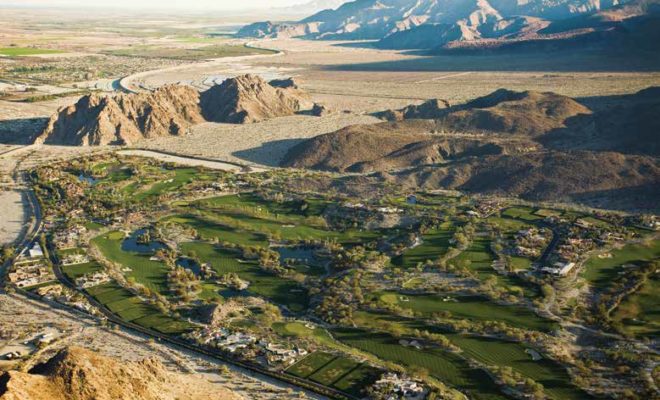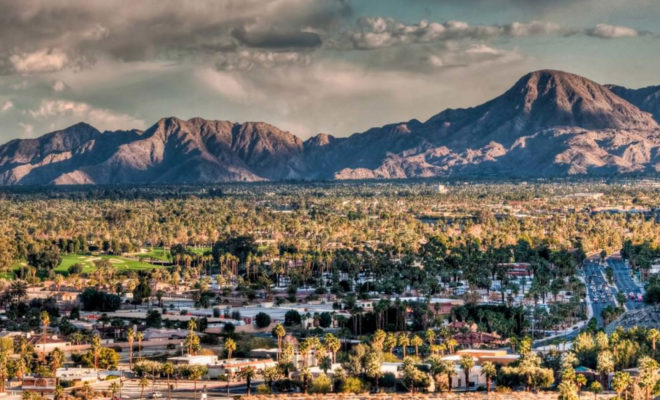A Class Unto Itself: California’s Coachella Valley

Sui generis — Latin for “a class unto itself.” Desert — there are lots of them in California, but only one when the subject is golf. Put them together and you have the Coachella Valley, the place where everything is different from everywhere else.
There is nowhere else where the golf economy is the chief driver of the local economy, nowhere else where so much of the region’s water is dedicated to maintaining golf courses, nowhere else where such a small percentage of the population supports such a high concentration of golf courses, nowhere else where Mother Nature provides so little water from the sky, nowhere else where it takes so much irrigation to sustain turf, and nowhere else where the fortunes of the game affect the fortunes of so many.
In short, the greatest concentration of golf courses is located in one of the hemisphere’s harshest deserts in a state beset by recurring droughts, a diminishing snowpack, a contracting golf industry, and rapidly rising water, energy and labor costs.
Despite all of that, the Coachella Valley is home to only 3.9 percent fewer golf holes in 2019 than it was when the nation’s markets were in free fall in 2008; water is still as plentiful and affordable as ever. Not exactly the story in the rest of California, where there are palpable pockets of decline and the price of water continues to escalate at many multiples of the Consumer Price Index; that is, when it’s available.
WHAT GIVES?
The story of golf in the Coachella Valley parallels the story of golf in the United States, except more so. From 1946 through 2005 there were more golf courses in the nation on December 31 of each and every year than there had been on January 1. Through wars, recessions, political crises, gas lines, stagflations and a whole host of dislocations, the game grew — faster during flush times to be sure, but it grew no matter what happened.
From 1944, when Tom O’Donnell organized O’Donnell GC as the Coachella Valley’s first golf club, through 2005, the growth was even more explosive in the desert — from one to 126.
An economist might call that a situation screaming for a market correction. And when markets that haven’t corrected for six decades start to correct, the correction can be steep. That hasn’t been the case on the national level, where the correction has been more of a long one than a steep one. But in the Coachella Valley, the correction has been almost imperceptible. Yesterday’s explosive growth has been replaced by stasis, and golf clubs and their companion HOAs have had to reconfigure some of their internal dynamics. But the kinds of closures and repurposes seen in places like North San Diego County and the Inland Empire have been absent.
An anomaly? Shouldn’t the greatest concentration of golf in the nation be more affected by a market correction than areas with a much lower supply to population ratio?
All things being equal, the answer would be yes. But not all things are equal when it comes to the desert golf market. The truth that those in the golf business understand is that golf’s fortunes have never been higher among two key demographics that practically define the desert golf market: persons between the ages of 55 and 74 and the affluent.
While golf has suffered among those under a certain age, the hard fact is that there are more golfers in the 55 to 74 age bracket today than there were in 2005 — considerably more according to most studies. And while golf has suffered among those in the middle quintiles of the income population, it has continued to grow among those in the top 20 percent.
WATER, WATER EVERYWHERE?
Golf may consume only 0.73 percent of the potable water consumed in the State of California, but it uses 24 percent of the water consumed in the Coachella Valley. Given the need to bring the state’s aquifers into balance and reduce overall water consumption, shouldn’t that statistic be cause for alarm?
Again, all things being equal, the answer would be a resounding yes. But also again, not all things are equal in the Coachella Valley, which sports one of the deepest and richest aquifers in the world and has access to a very generous Colorado River allocation per the terms of various federal compacts. The access and cost squeeze that dominates all discussion of golf’s sustainability virtually everywhere else in California just doesn’t exist in the Coachella Valley.
However, there are two things already baked into the desert’s cake guaranteed to inject a bit of what ails the rest of the state sometime in the 2020s: the full flowering of the regulatory scheme mandated by the 2014 Groundwater Sustainability Act, and reductions in Colorado River allocations made necessary by a drying Colorado River Basin that is already badly over-allocated.
The Coachella Valley golf community will continue to be a class unto itself no matter how much of what ails the rest of the state seeps into its environs, that much is certain. But as the rest of the state’s ailments do creep in and today’s 55- to 74-year-olds are replaced by a generation of 55- to 74-year-olds who don’t play golf in the same numbers, what is not yet certain is whether the Coachella Valley golf community can use the unique advantages it now enjoys to translate today’s stasis into a platform for tomorrow’s growth.










